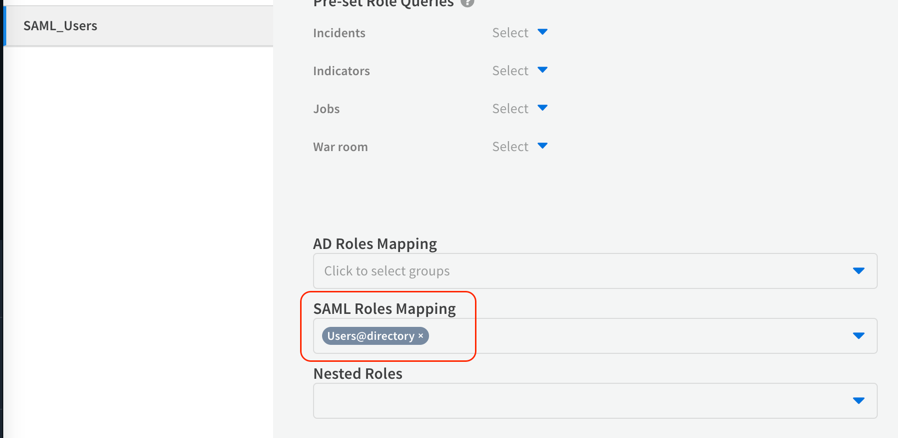SAML 2.0 - PingOne as IdP
You can authenticate your XSOAR users using SAML 2.0 authentication and PingOne as the identity provider. First, you have to define XSOAR authentication in your PingOne account, then create a SAML 2.0 instance in XSOAR.
SAML 2.0 Overview#
Security Assertion Markup Language 2.0 (SAML 2.0) is a version of the SAML standard. It uses security tokens for exchanging authentication and authorization data between security domains.
Definitions#
The following parameters are part of the configuration process.
| Parameter | Value |
|---|---|
| Service Provider | XSOAR |
| User Agent | User's browser |
| Identity Provider | PingOne |
Add XSOAR as a PingOne Application#
There are several steps you need to complete.
- Create PingOne Groups for XSOAR Users
- Define the PingOne application for XSOAR authentication
- Configure the SAML 2.0 integration in XSOAR
- Map PingOne groups to XSOAR roles
- More references to PingOne's documentation
Create PingOne Groups for XSOAR Users#
To authenticate XSOAR users with PingOne, you need to have at least one PingOne group that defines XSOAR users, which will eventually be mapped to XSOAR roles. There are two common methods for grouping and mapping users:
- Create a single PingOne group for all users, for example, XSOAR All Users.
- Create a PingOne group for each business unit, for example, XSOAR IT, XSOAR Analysts, XSOAR Admins.
To create and add users to a PingOne group, see Managing Users in the PingOne Documentation
Define the PingOne application for XSOAR authentication#
For information, see Add or update a SAML application in the PingOne documentation.
In the Application Configuration section, configure the following application parameters:
| Parameter | Value | Required |
|---|---|---|
| Protocol Version | SAML v 2.0 | True |
| Assertion Consumer Service (ACS) | https://<_XSOARURL_\>/saml | True |
| Entity ID | https://<_XSOARURL_\>/saml | True |
| Application URL | https://<_XSOARURL_\>/saml | False |
| Single Logout Endpoint | https://<_XSOARURL_\>/saml-logout | False |
| Single Logout Binding Type | POST | False |
| Primary Verification Certificate | Your own certificate. For help creating a new certificate go to the Set Up SAML Logout Article and follow Step 1. | False |
| Signing | Sign Response | False |
In the Group Access section, add each group that you would like to associate to this application. This is where you define which groups to associate with XSOAR, which will be mapped to XSOAR roles. For example, you can create a group that includes all users in a single group called Users.
Configure the SAML 2.0 Integration in XSOAR#
Before you configure an instance of the SAML 2.0 integration in XSOAR, access the PingOne Application Details. The values of several integration parameters are located here, such as Identity Provider Single Sign-On URL.
In XSOAR, navigate to Settings > Integrations > Servers & Services.
Search for SAML 2.0.
Click Add instance to configure a new integration instance.
Attribute Value Description Name A meaningful name for the integration instance. Service Provider Entity ID https://<_XSOARURL_\>/samlAlso known as an ACS URL. This is the URL of your XSOAR server. IdP metadata URL https://admin-api.pingone.com/latest/metadata/<UUID>
URL of your organization's IdP metadata file. Or: IdP metadata file Your organization's IdP metadata file. Download it from the PingOne UI: IdP SSO URL https://sso.connect.pingidentity.com/sso/idp/SSO.saml2?idpid=<idp_id_from_PingID_UI>.URL of the IdP application that corresponds to XSOAR. Attribute to get username urnAttribute in your IdP for the user name. Attribute to get email emailAttribute in your IdP for the user's email address. Attribute to get first name firstNameAttribute in your IdP for the user's first name. Attribute to get last name lastNameAttribute in your IdP for the user's last name. Attribute to get phone PhoneAttribute in your IdP for the user's phone number. Attribute to get groups memberOfAttribute in your IdP for the groups of which the user is a member. Groups delimiter ,Groups list separator. Default role Role to assign to the user when they are not a member of any group. RelayState Only used by certain IdPs. If your IdP uses relay state, you need to supply the relay state. Sign request and verify response signature Method for the IdP to verify the user sign-in request using the IdP vendor certificate. IdP public certificate Download it from the PingOne UI: Service Provider public certificate The certificate.crt.Public certificate for your IdP. Service Provider private key The private_unencrypted.key.Private key for your IdP, in PEM format. ADFS True Active Directory Federation Services. Compress encode URL (ADFS) True Will compress the request sent to PingOne. Service Identifier (ADFS) https://yourcompany.yourdomain.com/samlDo not map SAML groups to XSOAR roles SAML groups will not be mapped to XSOAR roles IdP Single Logout URL https://sso.connect.pingidentity.com/sso/SLO.saml2This functionality will end the user's session in PingOne when logging out. Click Test to validate the URLs, token, and connection.
Go back to the instance settings, and click Get service provider metadata, to verify that the settings are successful.

Map PingOne Groups to XSOAR Roles#
It is important that when you specify the PingOne group in XSOAR to map to a role that you use the exact group name as it appears in PingOne. Alternatively, you can specify .*, which will pass all PingOne groups to the relevant XSOAR roles (this is not recommended).
- In XSOAR, navigate to Settings > Users & Roles > Roles.
- To create a new role, click the +New button.
- Enter a meaningful name for the role.
- Select the permissions to grant to the role.
- In the SAML Roles Mapping section, specify one or more SAML groups to map to the XSOAR role.
